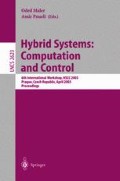Abstract
This paper describes the implementation of predicate abstraction techniques to automatically compute symbolic backward reachable sets of high dimensional piecewise affine hybrid automata, used to model Delta-Notch biological cell signaling networks. These automata are analyzed by creating an abstraction of the hybrid model, which is a finite state discrete transition system, and then performing the computation on the abstracted system. All the steps, from model generation to the simplification of the reachable set, have been automated using a variety of decision procedure and theorem-proving tools. The concluding example computes the reach set for a four cell network with 8 continuous and 256 discrete states. This demonstrates the feasibility of using these tools to compute on high dimensional hybrid automata, to provide deeper insight into realistic biological systems.
This research is supported by the DARPA Bio:Info:Micro program, grant MDA972- 00-1-0032, and the DARPA BioSpice program under contract DE-AC03-765F00098.
Access this chapter
Tax calculation will be finalised at checkout
Purchases are for personal use only
Preview
Unable to display preview. Download preview PDF.
References
R. Alur, T. Dang, and F. Ivancic. Reachability analysis of hybrid systems via predicate abstraction. In C. J. Tomlin and M. Greenstreet, editors, Hybrid Systems: Computation and Control, LNCS 2289, pages 35–48. Springer Verlag, 2002.
K. Amonlirdviman, R. Ghosh, J. Axelrod and C. Tomlin. A hybrid systems approach to modeling and analyzing planar cell polarity. In International Conference on Systems Biology, Stockholm, 2002.
E. Asarin, T. Dang, and O. Maler. d/dt: A verification tool for hybrid systems. In Proc. of the IEEE Conf. on Decision and Control, pages 2893–2898, Orlando, 2001.
A. Bemporad, F. D. Torrisi, and M. Morari. Optimization-based verification and stability characterization of piecewise affine and hybrid systems. In B. Krogh and N. Lynch, editors, Hybrid Systems: Computation and Control, LNCS 1790, pages 45–59. Springer Verlag, 2000.
S. Bensalem, V. Ganesh, Y. Lakhnech, C. Muñoz, S. Owre, H. Rueβ, J. Rushby, V. Rusu, H. Saϊdi, N. Shankar, E. Singerman, and A. Tiwari. An overview of SAL. In C. M. Holloway, editor, LFM 2000: Fifth NASA Langley Formal Methods Workshop, pages 187–196, Hampton, VA, June 2000. NASA Langley Research Center.
O. Botchkarev and S. Tripakis. Verification of hybrid systems with linear differential inclusions using ellipsoidal approximations. In B. Krogh and N. Lynch, editors, Hybrid Systems: Computation and Control, LNCS 1790, pages 73–88. Springer Verlag, 2000.
A. Chutinan and B. H. Krogh. Verification of infinite-state dynamic systems using approximate quotient transition systems. IEEE Trans. on Automatic Control, 46(9):1401–1410, 2001.
G. E. Collins. Quantifier elimination for the elementary theory of real closed fields by cylindrical algebraic decomposition. In Proc. Second GI Conf. Automata Theory and Formal Languages, LNCS 33, pages 134–183. Springer Verlag, 1975.
Computer Science Laboratory, SRI International, Menlo Park, California. SAL: Symbolic Analysis Laboratory. http://www.csl.sri.com/projects/sal/.
R. Ghosh and C. J. Tomlin. Lateral inhibition through delta-notch signaling: a piecewise affine hybrid model. In M. D. D. Benedetto and A. Sangiovanni-Vincentelli, editors, Hybrid Systems: Computation and Control, LNCS 2034, pages 232–246. Springer Verlag, 2001.
S. Graf and H. Saϊdi. Construction of abstract state graphs with PVS. In O. Grumberg, editor, Proc. 9th International Conference on Computer Aided Verification (CAV’97), volume 1254, pages 72–83. Springer Verlag, 1997.
T. A. Henzinger, P. H. Ho, and H. Wong-Toi. Hytech: A model checker for hybrid systems. Software Tools for Technology Transfer, 1:110–122, 1997.
H. Hong. An improvement of the projection operator in cylindrical algebraic decomposition. In Proc. ISAAC 90, pages 261–264, 1990.
H. de Jong. Modeling and simulation of genetic regulatory systems: A literature review. J. Computational Biology, 9(1):69–105, 2002.
B. Kuipers and S. Ramamoorthy. Qualitative modeling and heterogeneous control of global systems behavior. In C. J. Tomlin and M. Greenstreet, editors, Hybrid Systems: Computation and Control, LNCS 2289, pages 294–307. Springer Verlag, 2002.
G. Marnellos, G. A. Deblandre, E. Mjolsness, and C. Kintner. Delta-notch lateral inhibitory patterning in the emergence of ciliated cells in Xenopus: experimental observations and a gene network model. In Pacific Symposium on Biocomputing, pages 326–337, 2000.
S. McCallum. An improved projection operator for cylindrical algebraic decomposition of three dimensional space. J. Symbolic Computation, 5:141–161, 1988.
I. Mitchell. Application of level set methods to control and reachability problems in continuous and hybrid systems. PhD thesis, Stanford University, August 2002.
I. Mitchell and C. J. Tomlin. Overapproximating reachable sets by Hamilton-Jacobi projections. J. Symbolic Computation, 2003.
J. Preug and H. Wong-Toi. A procedure for reachability analysis of rectangular automata. In Proc. of the American Control Conference, pages 1674–1678, Chicago, 2000.
B. Shults and B. J. Kuipers. Proving properties of continuous systems: qualitative simulation and temporal logic. AI Journal, 92:91–129, 1997.
O. Sokolsky and H. S. Hong. Qualitative modeling of hybrid systems. In Proc. of the Montreal Workshop, 2001. Available from http://www.cis.upenn.edu/~rtg/rtg papers.htm.
A. Tarski. A Decision Method for Elementary Algebra and Geometry. University of California Press, second edition, 1948.
A. Tiwari and G. Khanna. Series of abstractions for hybrid automata. In C. J. Tomlin and M. Greenstreet, editors, Hybrid Systems: Computation and Control, LNCS 2289, pages 465–478. Springer Verlag, 2002.
Author information
Authors and Affiliations
Editor information
Editors and Affiliations
Rights and permissions
Copyright information
© 2003 Springer-Verlag Berlin Heidelberg
About this paper
Cite this paper
Ghosh, R., Tiwari, A., Tomlin, C. (2003). Automated Symbolic Reachability Analysis; with Application to Delta-Notch Signaling Automata. In: Maler, O., Pnueli, A. (eds) Hybrid Systems: Computation and Control. HSCC 2003. Lecture Notes in Computer Science, vol 2623. Springer, Berlin, Heidelberg. https://doi.org/10.1007/3-540-36580-X_19
Download citation
DOI: https://doi.org/10.1007/3-540-36580-X_19
Published:
Publisher Name: Springer, Berlin, Heidelberg
Print ISBN: 978-3-540-00913-9
Online ISBN: 978-3-540-36580-8
eBook Packages: Springer Book Archive

